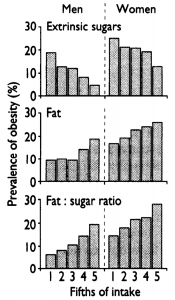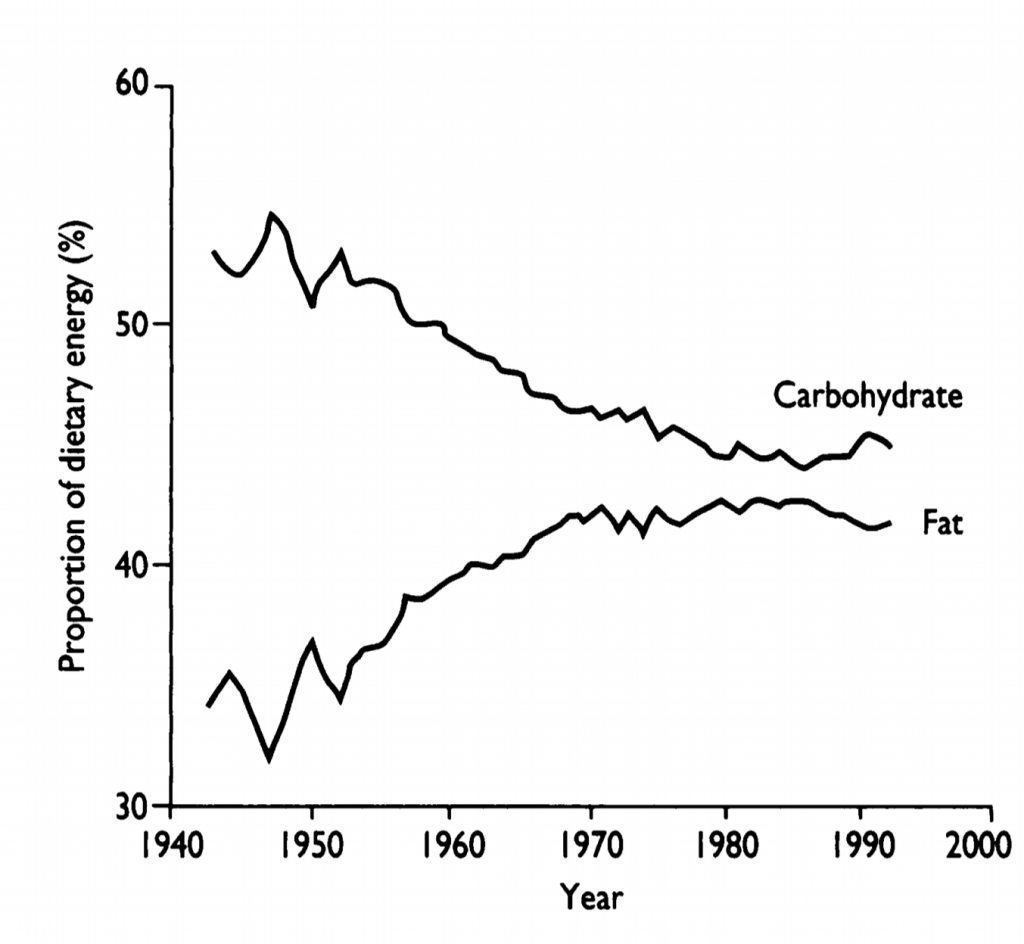 A reciprocal relationship between intakes of sugar and fat may exist. Such a relationship between these two macronutrients has been termed the sugar fat seesaw. The reciprocal relationship between sugar and fat is most evident when the fat and sugar content of the diet are expressed as a percentage of dietary energy. Therefore as the amount of energy a person derives from sugar increases, there is a concomitant decrease in the percentage of energy they derive from fat and vice versa. This reciprocal relationship has also been observed on the population scale. For example, since the 1940, the total amount of carbohydrate consumed as a percentage of total energy in Great Britain has decreased in a roughly linearly fashion. However, at the same time, the amount of fat that is consumed as a percentage of total energy has increased. In 1940 each kcal of carbohydrate was associated with 0.14 kcal of fat, However, by 1990, each kcal of carbohydrate was associated with 0.22 kcal of fat, and increase of close to 50 %.
A reciprocal relationship between intakes of sugar and fat may exist. Such a relationship between these two macronutrients has been termed the sugar fat seesaw. The reciprocal relationship between sugar and fat is most evident when the fat and sugar content of the diet are expressed as a percentage of dietary energy. Therefore as the amount of energy a person derives from sugar increases, there is a concomitant decrease in the percentage of energy they derive from fat and vice versa. This reciprocal relationship has also been observed on the population scale. For example, since the 1940, the total amount of carbohydrate consumed as a percentage of total energy in Great Britain has decreased in a roughly linearly fashion. However, at the same time, the amount of fat that is consumed as a percentage of total energy has increased. In 1940 each kcal of carbohydrate was associated with 0.14 kcal of fat, However, by 1990, each kcal of carbohydrate was associated with 0.22 kcal of fat, and increase of close to 50 %.
During the same period obesity has increased significantly, and this switch in dietary habits could therefore play some role in explaining this increasing prevalence of obesity. However, there are many confounding variables. For example, during this time, the amount of physical exercise performed has also fallen. In addition, while total carbohydrate intake has fallen, the amount of refined carbohydrate and sugars in the diet may have increased at least until the 1990’s, after which intake tailed off and remained somewhat constant. Identifying the cause of obesity is therefore difficult. However, some studies have investigated the role of the sugar fat seesaw in relation to the prevalence of obesity. For example, in one study 11 600 Scottish men and women were investigated for their level of obesity in quintiles for relative intakes of total sugars, total fats and fat to sugar ratio. The sugars were measured as total extrinsic sugars, which are all sugars not present in fruits and vegetables, and also excluding milk sugars.

Intakes of extrinsic sugars (total sugars, not including fruits, vegetables and milk sugars) and fat, in Scottish men and women in relation to the prevalence of obesity. As sugar intake increases, fat intake decreases and the prevalence of obesity also decreases.
Those subjects with the lowest intakes of extrinsic sugars had the highest intakes of fat and therefore the greatest fat to sugar ration. Contrary to expectations, it was these low sugar, high fat individuals that had the greatest prevalence of obesity. In contrast, those with the highest intakes of sugar, the lowest intake of fat and the lowest fat to sugar ratio had the lowest prevalence of obesity. Another interesting factor consider is the effect of alcohol. Evidence shows that those with the highest intakes of alcohol have the lowest risk of obesity. However, those with the highest intakes of alcohol also have the lowest intakes of sugar. Therefore it appears that reciprocity between macronutrients is complex and multiple interactions could be occurring. Often in analysis the type of sugar is also not considered, as whole grain sources of carbohydrate clearly do not have the same metabolic fate as sucrose. Whether sugar or fat is to blame for obesity is not clear, but aetiologically it is likely that both play a significant role.
Eat Well, Stay Healthy, Protect Yourself
RdB

